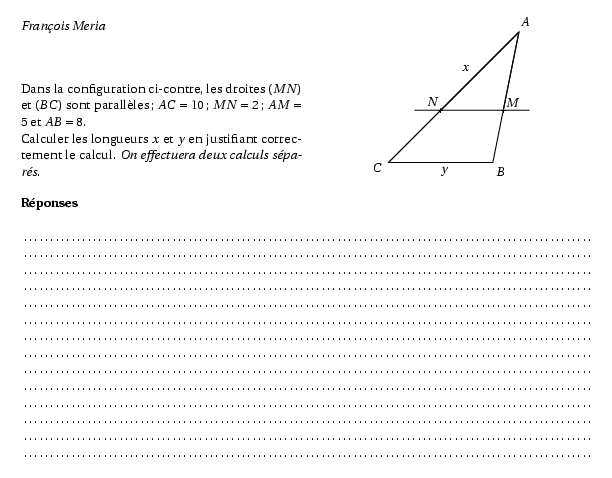Modifié le 21 Octobre 2006 à 19 h 32.

Source
%@Auteur: François Meria\par
\vspace*{1cm}\par
\begin{multicols}{2}
Dans la configuration ci-contre, les droites $(MN)$ et $(BC)$ sont
parallèles ; $AC=10$ ; $MN=2$ ; $AM=5$ et $AB=8$.\\
Calculer les longueurs $x$ et $y$ en justifiant correctement le
calcul. \textit{On effectuera deux calculs séparés}.
\columnbreak
\begin{center} \psset{unit=0.8cm}
\pspicture(2,2)(7,5.2) %\psgrid
\pstTriangle[PointSymbol=none,PosAngle={0,180}](7,7){A}(6,2){B}(2,2){C}
\pstHomO[HomCoef=0.6,PointSymbol=+,PosAngle=42]{A}{B}{M}
\pstHomO[HomCoef=0.6,PointSymbol=+,PosAngle=135]{A}{C}{N}
\pstLineAB{A}{M}%[nodesep=-2]
\pstLineAB{A}{N}%[nodesep=-2]
\pstLineAB{C}{B}%[nodesep=-1]
\pstLineAB[nodesep=-1]{M}{N}
\put(4.79,5.5){$x$}
\put(4,1.6){$y$}
\endpspicture
\end{center}
\end{multicols}
\textbf{Réponses}\\
\dotfill \\ \null \dotfill\\ \null \dotfill\\ \null \dotfill\\
\null \dotfill\\ \null \dotfill\\ \null \dotfill \\ \null \dotfill\\
\null \dotfill\\ \null \dotfill\\ \null \dotfill \\ \null \dotfill\\
\null \dotfill \\ \null \dotfill\\ \null \dotfill \\